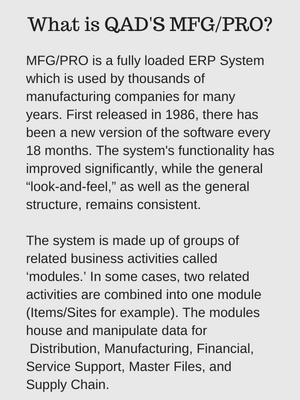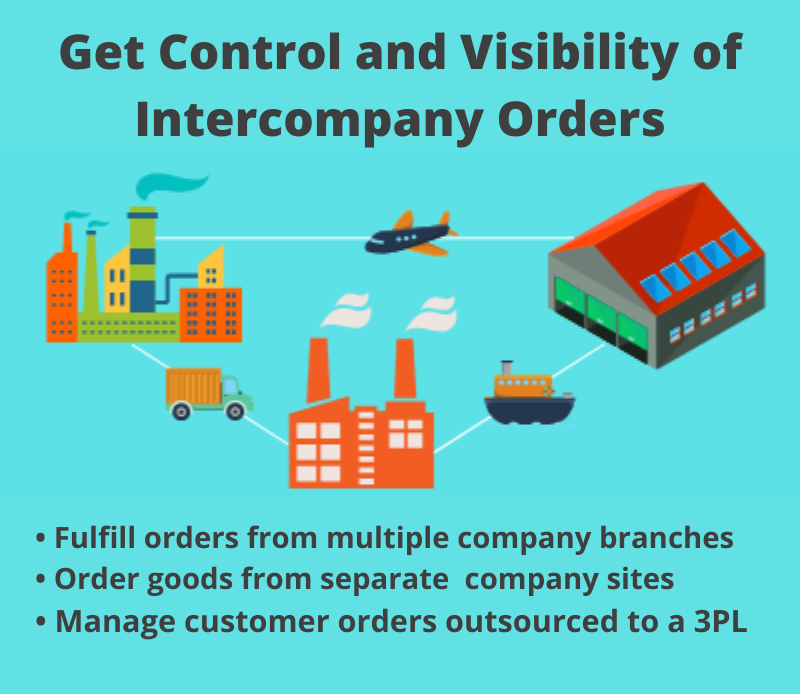
Introduction to QAD–Item Numbers
Item numbers are the bedrock of the QAD system. In general terminology, the item number is the identification number assigned to an item.
Also called a part number, SKU number, or SKU (Stock Keeping Unit), an item number can represent a service as well as a physical item. It is good practice to establish an item number for any billable entity. For example, one item number might represent a box of finished goods that are shipped to the customer, while another might represent a monthly rental fee. The rental fee is not a stocked or inventory unit which you can find in the warehouse. But assigning an item number to a service helps to improve data accuracy and unification.
Item Master Overview
Items in QAD are part of the core master data and used in nearly all system modules, such as manufacturing, distribution, and others. Item master maintenance can befound in the following menu: 1. Item/Sites->1.4. Item data menu. This submenu includes several programs which allow the user to maintain various item parameters, such as basic data, inventory data, planning data, and cost data.
 The menu is used to create a new item and maintain all its parameters in one screen. At the same time, the corresponding subscreens can be found in other standalone programs. Item master information, defined in (or in , , and ) is utilized as a master template, which can be used later to define site-specific data. In any QAD built-in transaction (for example, MRP, Work Order release or Sales Order maintenance) the system always is looking first for the site-specific record. If the site-specific record cannot be found, QAD will use the general (template) record.
The menu is used to create a new item and maintain all its parameters in one screen. At the same time, the corresponding subscreens can be found in other standalone programs. Item master information, defined in (or in , , and ) is utilized as a master template, which can be used later to define site-specific data. In any QAD built-in transaction (for example, MRP, Work Order release or Sales Order maintenance) the system always is looking first for the site-specific record. If the site-specific record cannot be found, QAD will use the general (template) record.
Sites
The Site usually represents a physical place where you manufacture or store inventory. It can be a distribution center, warehouse, manufacturing facility, or a combination of these. Inventory control and planning information are maintained by site, including inventory availability, manufacturing methods, costs, sales, purchasing data, manufacturing plans and orders, and forecasts. Sites are created and maintained in 1.1.13 Site Maintenance.
Business Considerations
Business Flow
One of the reasons to have multiple Item master sub-screens is that in many organizations, different people (departments) are responsible for different master data. For example, the company planner or scheduler updates the item planning data (maintained in menus 1.4.7 and 1.4.17, such as planning quantities and periods, lead times, etc.). Warehouse personnel is likely responsible for the item inventory data (maintained in menus 1.4.5 and 1.4.16, such as cycle counting intervals, default site and lot/serial control). Item Costing information (menus 1.4.9 and 1.4.18) is close to the heart of the Financial group – accountants and cost specialists.
Security access management becomes very easy when you use separate item data maintenance programs. Some organizations choose the following business flow:
- 1.4.1 menu – Item master maintenance is not accessible by the user community (administrators only)
- The Engineering Department can create new items in 1.4.3
- The Planning Department can update item planning and item-site planning data
- The Warehouse Department can update item inventory and item-site inventory data
- The Financial Group can update item cost data and item-site cost data
This model helps to ensure that only certain people are responsible for creating new items and that specific people can only modify specific information. Usually, this business model also includes a well-defined and strict change control process, where data cannot be altered without proper multi-level authorization and process documentation.
Segregation of Duties, Ownership and Centralized maintenance
Each company needs to decide how to implement the item number creation process based on their needs and internal organization, but there are a few best practices to follow. In most cases, the Engineering department is responsible for assigning the number s and other vital product/item parameters.
Companies with multi-site QAD implementations, however, face some business and technical challenges. There may be different company sites with ownership and responsibility for various items. Though this practice is acceptable and widespread, it is always best practice to centralize item master maintenance to avoid problems in item standardization and unification.
It is best to assign responsibility for new item creation to only one department in one location while maintaining site- specific information locally. This practice will necessitate the implementation of a data synchronization process to transfer master data between QAD databases automatically and to minimize manual input. It will also reduce the potential number of errors and the risk of data inconsistency.
There are a few options available that will help you synchronize master files.
- QAD Data Sync Product
- Automatic CIM load where information is sent from the master database to the target databases
- Semi-Automatic load, where notification is automatically sent, and data is loaded manually
- 32 Soft Data Loaders, which are MS Excel-based and offer a wealth of utilities to increase productivity, reduce errors and cleanly upload data from one QAD
In Multi-system operations where QAD coexists with other systems, such as Financial or Supply Chain, master data synchronization becomes even more critical. In this case, master records are maintained in one system and replicated into another. Again, it is wise to assign only one source for master data maintenance and to make the synchronization process as automatic as possible.
Item Number Creation
Item numbering concepts have been argued and discussed in the business community since the inception of ERP systems. Many propose that item numbers have some meaning. For example, the item number is structured so that you know it is a finished good, manufactured at the Plant A, and is to be stored in cold place. Others firmly believe that item numbers should be assigned randomly or sequentially. Both concepts have their pros and cons.
Meaningful Item numbers are user-friendly, helping system users to identify the products quickly. However, there is always a possibility—and it happens quite often— that the company will run out of options at some point.
Here is an example. Let’s say the second digit of an item number represents the item’s color. At the time of implementation, the company had only three colors of this product available, and everyone was sure there would not be more than ten colors offered in the future. Now, the product is available in 15 different colors, necessitating the need to use two digits to define the color options in the item number. What are the choices? You could add another digit to the item number, but this will affect the way the item number is printed or displayed in various reports and documents. You could substitute the digit with a letter, but this will change the initial numbering system and still not guarantee that a similar problem won’t occur in the future.
In contrast, using a random or sequential process to create item number does not create these complications. Of course, this option does not provide item numbers that are easy to decipher, but in the long run, it is the most recommended way to approach item number assignment.
Item Descriptions
Item descriptions in QAD consist of two lines, but the second line is not always shown on the reports. For this reason, it is recommended that you include as much information as possible in the first 24 characters of the item description. It is also best to keep the description of similar items in a consistent format. It will help in looking for an item while using lookups. For example:
Item A BOX, WOOD ,12”x15” Item B BOX, PLASTIC, 8”x15”
In this case, when pressing F2 for a lookup, and sorting items by description, you will get all your similar items (boxes, in this example) together.
Data Accuracy
Data accuracy is essential for successful QAD implementation. Here are a few examples. Inventory data is critical for the warehouse operations. Incorrect ABC class and cycle counting interval for an item will directly affect inventory accuracy since the item will not be counted in time. Inaccurate location type, which controls the storage, where this item can be placed, may result in item displacement and potential physical loss.
Planning Data is critical for the proper production scheduling and procurement planning. Order Policy controls the way the item is planned by MRP, and its wrong value may have a direct effect on the product availability and production.
Item Cost Data (GL Cost Set) is used by the system to generate GL transactions and to evaluate the inventory in the warehouse. Erroneous item cost will result in the wrong account balances and incorrect financial statements. Here we tried to cover only the most essential aspects of item master maintenance in QAD.
We Also Recommend:




